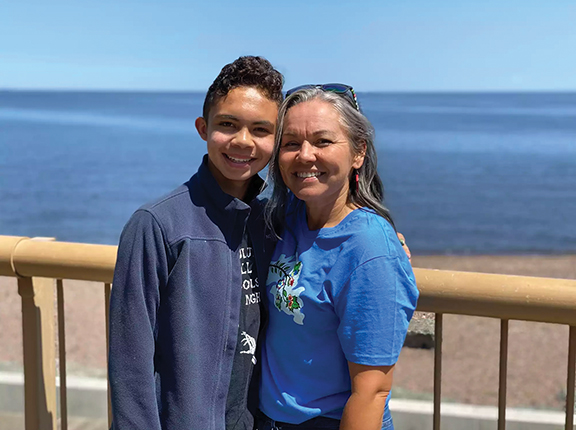
By Dan Kraker/MPR
Like a lot of Americans, Sarah Agaton Howes’ family is, as she puts it, “mixed from all over the place.” Her mom’s family is from Norway. Her dad is a member of the Fond du Lac Band of Lake Superior Chippewa, and so is she. But the 46-year-old also has relatives from the Red Cliff and Bad River Ojibwe bands in Wisconsin, and the Muscogee Nation in Oklahoma. Her husband is Filipino.
“And so my kids can’t be enrolled here,” she said of the Fond du Lac Band. “And so what that means for them is that even though they’re raised here, they grew up in our culture, that they aren’t going to be able to vote or feel a part of our community in the same way.”
Tribal members have cards that show their Certified Degree of Indian Blood. Howes’ is 25 percent. But because her kids’ dad is non-Native, they have only one-eighth blood quantum. So they can’t be enrolled tribal members.
“Our family, our kids have clans, they have names and so I know who they are. And they know who they are,” Howes said. “And the only one that doesn’t know who they are, is the enrollment office.”
But that could soon change, pending the outcome of a historic vote that could help determine who is allowed to be an enrolled tribal member.
The Minnesota Chippewa Tribe includes six Chippewa, or Ojibwe bands, in northern Minnesota, including the Fond du Lac Band. Only the Red Lake Band is not included. The Tribe’s constitution requires that a person have 25 percent tribal blood – a requirement known as “blood quantum.”
Tribal officials started counting ballots on July 26th on an advisory vote that will guide the tribe as it considers reforming its constitution. It’s a contentious issue that divides families. Some tribal members fear that expanding membership would further stretch already scarce resources.
But others argue that if nothing is done, the tribe’s enrollment will drastically decline as members marry non-tribal members.
“I think that we are fulfilling the government’s goal of making ourselves extinct if we don’t do something to change it.” said Melissa Walls, a descendant of the Bois Forte Band of Chippewa who doesn’t qualify for enrollment.
“And it totally flies in the face of Anishinaabe or any indigenous cultural teachings about who belongs.”
It isn’t real
Blood quantum is a relatively new idea, a race-based policy imposed by the federal government. Beginning in the 1930s the government pressured many tribes into adopting tribal constitutions that included blood quantum to decide membership. In Minnesota, it was used by white settlers to acquire tribal land. Federal law only allowed Native people who had “mixed blood” to sell their land.
But there was no way for federal officials to accurately determine the Native American percentage of an individual’s blood.
“Blood quantum isn’t actually a real thing,” said Jill Doerfler, chair of the American Indian Studies department at the University of Minnesota Duluth, who has studied blood quantum for two decades and written a book about it.
“It’s not something that can be carved up into percentages,” she said.
She said agents in Minnesota borrowed what were then cutting edge ideas and techniques from the burgeoning field of anthropology to try to quantify how much Native blood someone had.
“So they did some scratch tests on people’s chests,” Doerfler said, describing how they would look at the color of someone’s skin after they scratched it.
“They took some hair samples, they did some head measurements. And that was the basis for blood quantum and then later, even judges would see people before them and say, ‘Yes, mixed blood, no, full blood.’”
Doerfler said the Minnesota Chippewa Tribe historically had a much more open definition of belonging. But under pressure from the federal government, the tribe adopted the 25 percent blood quantum in the early 1960s.
Since then, the tribe’s population has slowly declined, as tribal members married non-tribal members. Doerfler calls it “mathematical termination.”
Today, out of a total population of around 40,000 among the six bands, fewer than 20 percent are children. A study conducted by Wilder Research nearly a decade ago on behalf of the Minnesota Chippewa Tribe found that if no changes are made, the tribe’s population would decline 80 percent by the end of the century.
“If something isn’t done, tribes will eventually be gone. The population could dwindle to the point of non-existence,” said Cathy Chavers, chairwoman of the Bois Forte Band and the current President of the Minnesota Chippewa Tribe.
In June the tribe sent out ballots to its roughly 33,000 eligible voters. They asked two questions. Should the tribe eliminate the blood quantum? And should the tribe’s six member Bands be allowed to determine their own tribal enrollment criteria?
The vote is only advisory. But it will play a key role in guiding the tribe as it considers reforming its constitution. Chavers said she often hears from tribal members who want their kids and grandkids to also be enrolled.
“They feel like they’re Native. They want to be Native. Their heart says they’re Native, but then the blood quantum says they’re not.”
Hard to change
Blood quantum is an artificial concept that the federal government imposed on tribal governments to limit their citizenship. But it’s proven difficult for the Minnesota Chippewa Tribe to abandon.
“Some people have latched on to blood quantum,” said Doerfler. “Many people have made deliberate choices to make sure they were producing children that would have the proper blood quantum to be enrolled tribal members. They did the math.”
Some members of bands that distribute casino revenues to tribal citizens through monthly “per capita payments” don’t want enrollment expanded, Chavers said.
She said there are also concerns that expanded tribal membership could further stretch already scarce resources, for housing and other services. “The federal government has never upheld their trust responsibility. We’ve been underfunded for hundreds of years. If you add more enrollment, yes, more people will be eligible, but the funding won’t be there to follow it.”
Doerfler says there’s some truth to that argument. But she said it also saddens her. She said not everyone who’s seeking enrollment is looking to get something. She said many want a validation of their identity, including herself.
Doerfler grew up on the White Earth reservation and went to school there. But she’s not an enrolled member because she doesn’t meet the blood quantum requirement. “If I were to be enrolled, I would not qualify for any services, nor should I. I would hope that I could make some sort of contribution. And I would like to have the recognition, the legal and political recognition of being Anishinaabe,” she said.
According to Sarah Howes from the Fond du Lac Band, it’s a painful argument that divides families.
“What would our ancestors think of us? If they were looking at us? And we’re saying, Oh, we don’t include these kids, because we’re worried about our $400 [per capita payment]. I think they would be ashamed of us.”
Howes said she would gladly return her per capita payments if it meant her kids could harvest wild rice, spear fish and exercise treaty rights that her ancestors secured for future generations.
Chavers said it could take a couple days to count the advisory ballots. She said about 7,000 ballots were returned; only about 20 percent of what was sent out.
That concerns her. If the tribe were eventually to vote on eliminating the blood quantum rule, that would require approval from 30 percent of members.
“If we can’t get that threshold,” she said, “there’s no way we’re going to be able to change the constitution.”
It will likely take several months before the Tribe decides how to proceed. Chavers said a constitution reform committee will present a report with the election results at the tribal executive committee’s next meeting in October.
Minnesota Public Radio News can be heard on MPR’s statewide radio network or online.






